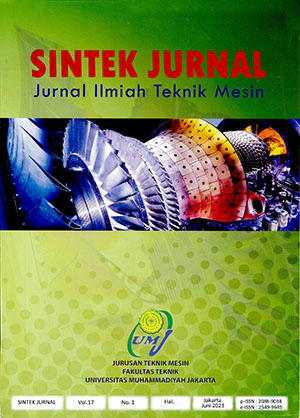Performance comparison of one cylinder combustion engine with variations of compression pressure & octane number gasoline
Main Article Content
Abstract
Article Details
- Articles published in SINTEK JURNAL are licensed under a Creative Commons Attribution-ShareAlike 4.0 International license. You are free to copy, transform, or redistribute articles for any lawful purpose in any medium, provided you give appropriate credit to the original author(s) and SINTEK JURNAL, link to the license, indicate if changes were made, and redistribute any derivative work under the same license.
- Copyright on articles is retained by the respective author(s), without restrictions. A non-exclusive license is granted to SINTEK JURNAL to publish the article and identify itself as its original publisher, along with the commercial right to include the article in a hardcopy issue for sale to libraries and individuals.
- By publishing in SINTEK JURNAL, authors grant any third party the right to use their article to the extent provided by the Creative Commons Attribution-ShareAlike 4.0 International license.
References
Heywood, J. B. (1988). Internal Combustion Engine Fundamentals. McGraw-Hill Education. ISBN: 978-0070286375.
Taylor, C. F. (1985). The Internal Combustion Engine in Theory and Practice: Volume 1: Thermodynamics, Fluid Flow, Performance. MIT Press. ISBN: 978-0262510379.
Stone, R. (1999). Introduction to Internal Combustion Engines. Palgrave Macmillan. ISBN: 978-0333734971.
Watson, N., & Janota, M. S. (1982). Fuel octane effects on the performance of high compression ratio spark ignition engines. SAE Technical Paper Series, 820022.
Watson, H. C. (1997). Octane number and knock in the highspeed internal combustion engine. SAE Technical Paper Series, 972950.
Fletcher, T. H., Dempsey, A. B., & Miller, D. L. (2001). High compression ratio effects on fuel consumption, emissions, and heavy-duty diesel engine performance. SAE Technical Paper Series, 2001-01-0192.
Dec, J. E. (2010). Advanced compression-ignition engines—understanding the in-cylinder processes. Proceedings of the Combustion Institute, 33(1), 2729-2750.
Naber, J. D., & Siebers, D. L. (1996). Effects of fuel properties on combustion and emissions of homogeneous charge compression ignition (HCCI) engines. SAE Technical Paper Series, 962084.
Lapuerta, M., Armas, O., & Rodríguez-Fernández, J. (2010). Compression ratio influence on performance and emissions of an HSDI diesel engine fuelled with 2,5-dimethylfuran. Fuel, 89(12), 3695-3701.
Syed, J., & Sreenivasan, K. (2014). Investigation of the effect of compression ratio on performance, combustion and emission characteristics of a diesel engine fuelled with ethanol-diesel blends. Fuel, 137, 184-193.


